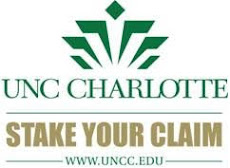First Ward Park Grand
Opening
Tuesday, December 8,
2015
Chancellor Philip L. Dubois' Remarks
Thank you, Daniel (Levine), and
thank you all for being here for this exciting celebration.
It's great to see so
many friendly faces here who have enabled this vision to become reality. It has
been a long time coming but, as you can see from the results, it was well worth
it. Won’t this be a great place to
celebrate the Panthers winning the Super Bowl!
| First Ward Park connects UNC Charlotte Center City (lower right) with the core of Uptown Charlotte. |
In 2006, The North
Carolina General Assembly appropriated $50 million for the 11-story building
that anchors this site. That important decision, along with the decision of the
Levine Family to convey this property to the University Foundation in a
generous sale and gift arrangement, launched the public-private partnership
represented here today.
We knew we wanted to
build an iconic structure to anchor our presence in First Ward. But we also knew that we wanted to create a
link to the rest of Center City and, indeed, the rest of the larger
community. Working with Daniel, the city,
and the county (as well as a host of elected representatives who shared this
vision), we were able to build an open space that welcomes all into UNC
Charlotte—Center City. And it also
protects, in perpetuity, our ability to enjoy the impressive skyline that is
Center City Charlotte.
| First Ward Park is designed with iconic spaces. |
By all measures, the
Center City Campus is exceeding expectations as a vibrant pillar of First Ward.
As the home of the Belk College of Business graduate programs, the Urban
Education Collaborative in the College of Education, and the Urban Design
program within our College of Arts + Architecture, over 1800 students attend
classes here each week. Thousands of participants in the Continuing Education
certificate program receive their professional training at the building. And
most notably, Center City is the home to over 500 University and community
events that attract 30,000 visitors annually to the building.
In the summer of 2017,
those visitors will soon have an easier time of getting here when light rail
opens up the link between Center City and the main UNC Charlotte campus in
spring 2017.
We are excited about
what has been accomplished through this incredible partnership, and we look
forward to seeing what the future holds as we work together to strengthen First
Ward. We are proud to be your neighbor and, on behalf of our Center City campus,
we hope you'll enjoy some hospitality in the form of hot cocoa and cookies
to enhance this celebration.
We are thrilled that
this day has finally come and we look forward to a park filled with 49ers for
years to come. Have a great day and enjoy your time in the park.
# # #










